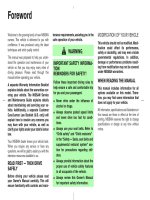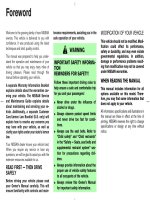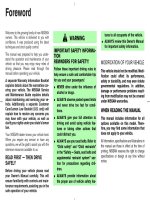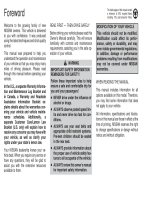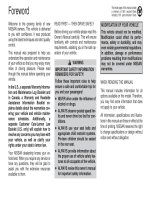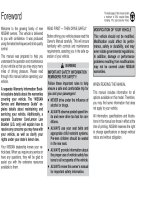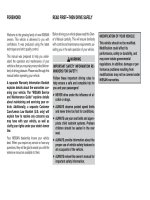Nissan Rogue 2008 owner manual - Sách hướng dẫn sử dụng xe Nissan Rogue đời 2008
Bạn đang xem bản rút gọn của tài liệu. Xem và tải ngay bản đầy đủ của tài liệu tại đây (4.45 MB, 309 trang )
Black plate (2,1)
Model "S35-D" EDITED: 2007/ 7/ 3
Welcome to the growing family of new NISSAN
owners. This vehicle is delivered to you with
confidence. It was produced using the latest
techniques and strict quality control.
This manual was prepared to help you under-
stand the operation and maintenance of your
vehicle so that you may enjoy many miles of
driving pleasure. Please read through this
manual before operating your vehicle.
A separate Warranty Information Booklet
explains details about the warranties cov-
ering your vehicle. The NISSAN Service
and Maintenance Guide explains details
about maintaining and servicing your ve-
hicle. Additionally, a separate Customer
Care/Lemon Law Booklet (U.S. only) will
explain how to resolve any concerns you
may have with your vehicle, as well as
clarify your rights under your state’s lemon
law.
Your NISSAN dealer knows your vehicle best.
When you require any service or have any
questions, we will be glad to assist you with the
extensive resources available to us.
READ FIRST — THEN DRIVE SAFELY
Before driving your vehicle, read your Owner’s
Manual carefully. This will ensure familiarity with
controls and maintenance requirements, assist-
ing you in the safe operation of your vehicle.
WARNING
IMPORTANT SAFETY INFORMA-
TION REMI NDERS FOR SAFETY!
Follow these important driving rules to
help ensure a safe and comfortable trip
for you and your passengers!
. NEVER drive under the influence of
alcohol or drugs.
. ALWAYS observe posted speed lim-
its and never drive too fast for
conditions.
. ALWAYS give your full attention to
driving and avoid using vehicle
features or taking other actions that
could distract you.
. ALWAYS use your seat belts and
appropriate child restraint systems.
Pre-teen children should be seated
in the rear seat.
. ALWAYS provide information about
the proper use of vehicle safety
features to all occupants of the
vehicle.
. ALWAYS review this Owner’s Man-
ual for important safety information.
ON-PAVEMENT AND OFF-ROAD
DRIVING
This vehicle will handle and maneuver
differently from an ordinary passenger
car because it has a higher center of
gravity for off-road use. As with other
vehicles with features of this type, failure
to operate this vehicle correctly may
result in loss of control or an accident.
Be sure to read “On-pavement and off-
road driving precautions”, “Avoiding colli-
sion and rollover” and “Driving safety
precautions” in the “5. Starting and driv-
ing” section of this manual.
MODIFICATION OF YOUR VEHICLE
This vehicle should not be modified.
Modification could affect its performance,
safety or durability, and may even violate
governmental regulations. In addition,
damage or performance problems result-
ing from modification may not be covered
under NISSAN warranties.
WHEN READING THE MANUAL
This manual includes information for all
options available on this model. Therefore,
you may find some information that does
not apply to your vehicle.
Foreword
Black plate (3,1)
Model "S35-D" EDITED: 2007/ 7/ 3
All information, specifications and illustrations in
this manual are those in effect at the time of
printing. NISSAN reserves the right to change
specifications or design at any time without
notice.
IMPORTANT INFORMATION ABOUT
THIS MANUAL
You will see various symbols in this manual. They
are used in the following ways:
WARNING
This is used to indicate the presence of
a hazard that could cause death or
serious personal injury. To avoid or
reduce the risk, the procedures must
be followed precisely.
CAUTION
This is used to indicate the presence of
a hazard that could cause minor or
moderate personal injury or damage to
your vehicle. To avoid or reduce the risk,
the procedures must be followed care-
fully.
SIC0697
If you see the symbol above, it means “Do not
do this” or “Do not let this happen”.
If you see a symbol similar to those above in an
illustration, it means the arrow points to the front
of the vehicle.
Arrows in an illustration that are similar to those
above indicate movement or action.
Arrows in an illustration that are similar to those
above call attention to an item in the illustration.
CALIFORNIA PROPOSITION 65
WARNING
WARNING
Engine exhaust, some of its constitu-
ents, and certain vehicle components
contain or emit chemicals known to the
State of California to cause cancer and
birth defec ts or other repr oductive
harm. In addition, certain fluids con-
tained in vehicles and certain products
of component wear contain or emit
chemicals known to the State of Cali-
fornia to cause cancer and birth defects
or other reproductive harm.
CALIFORNIA PERCHLORATE ADVI-
SORY
Some vehicle parts, such as lithium bat-
teries, may contain perchlorate material.
The following advisory is provided: “Per-
chlorate Material - special handling may
apply, See www.dtsc.ca.gov/
hazardouswaste/perchlorate.”
Black plate (5,1)
Model "S35-D" EDITED: 2007/ 7/ 3
NISSAN CARES
Both NISSAN and your NISSAN dealer are dedicated to serving all your automotive needs. Your satisfaction with your vehicle and your NISSAN dealer are
our primary concerns. Your NISSAN dealer is always available to assist you with all your automobile sales and service needs.
We appreciate your interest in NISSAN and thank you for buying a quality NISSAN vehicle.
However, if there i s someth ing that your
NISSAN dealer cannot assist you with or you
would like to provide NISSAN directly with
comments or questions, please contact the
NISSAN Consumer Affairs Department using
our toll-free number:
For U.S. customers
1-800-NISSAN-1
(1-800-647-7261)
For Canadian customers
1-800-387-0122
The Consumer Affairs Department will ask for
the following information:
— Your name, address, and telephone number
— Vehicle identification number (attached to
the top of the instr ument panel on the
driver’s side)
— Date of purchase
— Current odometer reading
— Your NISSAN dealer’s name
— Your comments or questions
OR
You can write to NISSAN with the information at:
For U.S. customers
Nissan North America, Inc.
Consumer Affairs Department
P.O. Box 685003
Franklin, TN 37068-5003
For Canadian customers
Nissan Canada Inc.
5290 Orbitor Drive
Mississauga, Ontario L4W 4Z5
NISSAN CUSTOMER CARE
PROGRAM
Black plate (1,1)
Table of
Contents
Model "S35-D" Edited: 2007/ 7/ 3
Illustrated table of contents
0
Safety — Seats, seat belts and supplemental
restraint system
1
Instruments and controls
2
Pre-driving checks and adjustments
3
Heater, air conditioner, audio and phone systems
4
Starting and driving
5
In case of emergency
6
Appearance and care
7
Maintenance and do-it-yourself
8
Technical and consumer information
9
Index
10
Black plate (4,1)
Model "S35-D" EDITED: 2007/ 7/ 3
BLUETOOTH
®
is a trademark
owned by Bluetooth SIG, Inc.,
U.S.A. and licenced to Visteon
Corporation.
*
C
2007 NISSAN MOTOR CO., LTD.
All rights reserved. No part of this Owner’s
Manual may be repro duced or stored in a
retrieval system, or transmitted in any form, or
by any means, electronic, mechanical, photo-
copying, recording or otherwise, without the
prior written permission of Nissan Motor Co.,
Ltd.
Black plate (1,1)
Seats, seat belts and Supplemental Restraint
System (SRS) 0-2
Exterior front 0-3
Exterior rear 0-4
Passenger compartment 0-5
Instrument panel 0-6
Meters and gauges 0-7
Engine compartment 0-8
QR25DE engine 0-8
0 Illustrated table of contents
Model "S35-D" EDITED: 2007/ 7/ 3
Black plate (4,1)
Model "S35-D" EDITED: 2007/ 7/ 4
SSI0348
1. Supplemental front-impact air bags (P.1-38)
2. Front seat-mounted side-impact sup plemental air
bags (P.1-38)
3. Seat belts (P.1-9)
4. Head restraints (P.1-7)
— Front-seat Active Head Restraints (P.1-8)
5. Roof-mounted curtain side-impact and rollover
supplemental air bags (P.1-38)
6. Rear center seat belt (P.1-16)
7. Occupant classification sensor (pattern sensor)
— Advanced air bag system (P.1-44)
8. Front seats (P.1-3)
9. Seat belt pretensioner (P.1-49)
10. Rear seats (P.1-6)
— Child restraints (P.1-19)
11. LATCH (Lower Anchors and Tethers for CHildren)
system (P.1-21)
12. Child restraint anchor points (for top tether strap
child restraint) (P.1-22)
SEATS, SEAT BELTS AND
SUPPLEMENTAL RESTRAINT
SYSTEM (SRS)
0-2 Illustrated table of contents
Black plate (5,1)
Model "S35-D" EDITED: 2007/ 7/ 3
SSI0349
1. Hood (P.3-19)
2. Headlight and turn signal lights
— Switch operation (P.2-25)
— Bulb replacement (P.8-25)
3. Windshield wiper and washer
— Switch operation (P.2-22)
— Blade replacement (P.8-16)
— Window washer fluid (P.8-12)
4. Roof rack (rail)* (P.2-39)
5. Moonroof* (P.2-42)
6. Outside mirrors (P.3-25)
7. Power windows (P.2-40)
8. Recovery hook (P.6-15)
9. License plate installation (P.9-11)
10. Fog lights*
— Switch operation (P.2-29)
— Bulb replacement (P.8-26)
11. Tires
— Wheel and tires (P.8-30, P.9-7)
— Flat tire (6-2)
— Tire Pressure Monitoring System (TPMS)
(P.2-14, P.5-3)
12. Doors
— Keys (P.3-2)
— Door locks (P.3-4)
— Intelligent Key system* (P.3-8)
— Remote keyless entry system* (P.3-6)
— Security system (P.2-19)
13. Child safety rear door lock (P.3-5)
*: if so equipped
EXTERIOR FRONT
Illustrated table of contents 0-3
Black plate (6,1)
Model "S35-D" EDITED: 2007/ 7/ 3
SSI0350
1. Lift gate (P.3-20)
— Intelligent Key system* (P.3-8)
2. Rear window wiper and washer
— Switch operation (P.2-23)
— Window washer fluid (P.8-12)
3. Rear window defroster (P.2-24)
4. High-mounted stop light
— Bulb replacement (P.8-26)
5. Antenna (P.4-24)
— Satellite radio antenna* (P.4-7)
6. Back-up light
— Bulb replacement (P.8-26)
7. Rear combination light
— Bulb replacement (P.8-26)
8. Fuel-filler door
— Operation (P.3-21)
— Fuel recommendation (P.9-3)
*: if so equipped
EXTERIOR REAR
0-4 Illustrated table of contents
Black plate (7,1)
Model "S35-D" EDITED: 2007/ 7/ 3
SSI0351
1. Cargo cover* (P.2-37)
2. Coat hooks (P.2-38)
3. Ceiling light (P.2-45)
4. Door armrest
— Power window switch (P.2-40)
— Power door lock switch (P.3-5)
5. Sun visors (P.3-23)
6. Moonroof* (P.2-42)
7. Front map lights (P.2-44)
8. Sunglasses holder (P.2-34)
9. Inside rearview mirror (P.3-24)
— Anti-glare adjustment* (P.3-24)
— HomeLink
®
universal transceiver* (P.2-47)
— Compass* (P.2-8)
10. Cargo area
— Storages (P.2-36)
— Luggage hooks (P.2-38)
— Cargo light* (P.2-46)
— Spare tire (P.6-3)
11. Rear cup holders (P.2-33)
12. Console box (P.2-35)
— Power outlet* (P.2-32)
13. Front cup holders (P.2-33)
*: if so equipped
PASSENGER COMPARTMENT
Illustrated table of contents 0-5
Black plate (8,1)
Model "S35-D" EDITED: 2007/ 7/ 4
SIC3470
1. Side ventilator (P.4-2)
2. Headlight, fog light* and turn signal switch
(P.2-25)
3. Paddle shifter* (P.5-14)
4. Steering-wheel-mounted controls (left side)*
— Audio control* (P.4-23)
— Bluetooth
®
Hands-Free Phone System control*
(P.4-25)
5. Steering wheel
— Horn (P.2-30)
— Driver supplemental air bag (P.1-38)
— Electric power steering system (P.5-25)
6. Meters and gauges (P.2-3)
7. Steering-wheel-mounted controls (right side)
— Cruise control switches (P.5-18)
8. Wiper and washer switch (P.2-22)
9. Center ventilator (P.4-2)
10. Hazard warning flasher switch (P.2-29)
11. Audio system (P.4-6)
— Clock (P.2-31)
12. Front passenger supplemental air bag (P.1-38)
13. Outside remote mirror control switch (P.3-25)
14. Headlight aiming control* (P.2-27)
15. All-Wheel Drive (AWD) LOCK switch* (P.5-21)
16. Fuse box cover (P.8-20)
17. Vehicle Dynamic Control (VDC) OFF switch
(P.2-31, 5-27)
18. Hood release handle (P.3-19)
19. Tilting steering wheel lever (P.3-23)
20. Parking brake (P.5-17)
21. Ignition switch (P.5-8)
22. Heated seat switch* (P.2-30)
23. Power outlet (P.2-32)
24. Heater/air conditioner control (P.4-2)
25. Selector lever (P.5-12)
26. Front passenger air bag status light (P.1-45)
27. Rear window and outside mirror* defroster switch
(P.2-24)
28. Glove box (P.2-35)
*: if so equipped
INSTRUMENT PANEL
0-6 Illustrated table of contents
Black plate (9,1)
Model "S35-D" EDITED: 2007/ 7/ 3
SIC3471
1. Tachometer (P.2-5)
2. Fuel gauge (P.2-6)
3. Vehicle information display (P.2-6)
— Odometer/twin trip odometer (P.2-4)
— Trip computer* (P.2-7)
— Outside air temperature* (P.2-6)
— Continuously Variable Transmission (CVT)
position indicator (P.2-7)
4. Engine coolant temperature gauge (P.2-5)
5. Speedometer (P.2-4)
6. Warning/indicator lights (P.2-11)
7. Instrument brightness control knob (P.2-28)
8. RESET switch for trip odometer (P.2-4)/Trip
computer* mode switch (P.2-7)
*: if so equipped
METERS AND GAUGES
Illustrated table of contents 0-7
Black plate (10,1)
Model "S35-D" EDITED: 2007/ 7/ 3
SDI2127
QR25DE ENGINE
1. Engine oil filler cap (P.8-8)
2. Brake fluid reservoir (P.8-11)
3. Air cleaner (P.8-16)
4. Coolant reservoir (P.8-8)
5. Window washer fluid reservoir (P.8-12)
6. Drive belt location (P.8-14)
7. Engine oil dipstick (P.8-8)
8. Radiator filler cap (P.8-7)
9. Battery (P.8-13)
10. Fuse/fusible link holder (P.8-19)
ENGINE COMPARTMENT
0-8 Illustrated table of contents
Black plate (4,1)
1 Safety — Seats, seat belts and supple-
mental restraint system
Model "S35-D" EDITED: 2007/ 7/ 3
Seats 1-2
Front seats 1-3
Rear seats 1-6
Head restraints 1-7
Front-seat Active Head Restraints 1-8
Seat belts 1-9
Precautions on seat belt usage 1-9
Child safety 1-11
Pregnant women 1-12
Injured persons 1-12
Three-point type seat belt 1-12
Seat belt extenders 1-18
Seat belt maintenance 1-19
Child restraints 1-19
Precautions on child restraints 1-19
Lower Anchors and Tethers for CHildren system
(LATCH) 1-21
Top tether strap child restraint 1-22
Child restraint installation using LATCH 1-24
Child restraint installation using the seat belts 1-28
Booster seats 1-34
Precautions on booster seats 1-34
Booster seat installation 1-36
Supplemental restraint system 1-38
Precautions on supplemental restraint system 1-38
NISSAN advanced air bag system (front seats) 1-44
Front seat-mounted side-impact supplemental
air bag and roof-mounted curtain side-impact
and rollover supplemental air bag systems 1-48
Seat belts with pretensioners (front seats) 1-49
Supplemental air bag warning labels 1-50
Supplemental air bag warning light 1-51
Repair and replacement procedure 1-51
Black plate (14,1)
Model "S35-D" EDITED: 2007/ 7/ 3
SSS0133
WARNING
. Do not ride in a moving vehicle
when the seatback is reclined. This
can be dangerous. The shoulder belt
will not be against your body. In an
accident, you could be thrown into it
and receive neck or other serious
injuries. You could also slide under
the lap belt and receive serious
internal injuries.
. For the most effectiv e protection
when the vehicle is in motion, the
seat should be upright. Always sit
well back in the seat with both feet
on the floor and adjust the seat
properly. See “PRECAUTIONS ON
SEAT BELT USAGE” later in this
section.
. After adjustment, gently rock in the
seat to make sure it is securely
locked.
. Do not leave children unattended
inside the vehicle. They could un-
knowingly activate switches or con-
trols. Unattended children could
become involved in serious acci-
dents.
. Do not adjust the driver’s seat while
driving so full attention may be
given to vehicle operation. The seat
may move suddenly and could
cause loss of control of the vehicle.
SEATS
1-2 Safety — Seats, seat belts and supplemental restraint system
Black plate (15,1)
Model "S35-D" EDITED: 2007/ 7/ 3
SSS0792
FRONT SEATS
Front manual seat adjustment
Forward and backward:
Pull the lever
*
1
up and hold it while you slide
the seat forward or backward to the desired
position. Release the lever to lock the seat in
position.
Reclining:
To recline the seatback, pull the lever
*
2
up and
lean back. To bring the seatback forward, pull
the lever up and lean your body forward. Release
the lever to lock the seatback in position.
The reclining feature allows adjustment of the
seatback for occupants of different sizes for
added comfort and to help obtain proper seat
belt fit. (See “PRECAUTIONS ON SEAT BELT
USAGE” later in this section.) Also, the seatback
can be reclined to allow occupants to rest when
the vehicle is stopped and the transmission in
the P (Park) position.
SSS0793
Seat lifter (if so equipped):
Pull up or push down the adjusting lever to
adjust the seat height until the desired position
is achieved.
Safety — Seats, seat belts and supplemental restraint system 1-3
Black plate (16,1)
Model "S35-D" EDITED: 2007/ 7/ 3
Front power seat adjustment
Operating tips:
. The seat motor has an auto-reset overload
protection circuit. If the motor stops during
operation, wait for a while, then reactivate
the switch.
. Do not operate the power seat for a long
period of time when the engine is off. This
will discharge the battery.
SSS0661
Forward and backward:
Moving the switch
*
1
forward or backward will
slide the seat forward or backward to the
desired position.
Reclining:
Move the recline switch
*
2
backward until the
desired angle is obtained. To bring the seatback
forward again, move the switch
*
2
forward.
The reclining feature allows adjustment of the
seatback for occupants of different sizes for
added comfort and to help obtain proper seat
belt fit. (See “PRECAUTIONS ON SEAT BELT
USAGE” later in this section.) Also, the seatback
can be reclined to allow occupants to rest when
the vehicle is stopped and the transmission in
the P (Park) position.
1-4 Safety — Seats, seat belts and supplemental restraint system
Black plate (17,1)
Model "S35-D" EDITED: 2007/ 7/ 3
SSS0794
Seat lifter (if so equipped):
Pull up or push down the adjusting switch to
adjust the height of the seat.
SSS0795
Lumbar support (if so equipped):
The lumbar support feature provides lower back
support to the driver.
Push the front
*
1
or back
*
2
end of the switch
to adjust the seat lumbar area.
SSS0796
Folding front passenger’s seat
The front passenger’s seatback can be folded
down. Some long objects may be loaded in the
vehicle when the rear seats are also folded
down. (See “REAR SEATS” later in this section
for folding rear seats.)
To fold the front passenger’s seatback, pull the
reclining lever all the way
*
1
.
When returning the front passenger’s seatback
to a seating position, lift it up to an upright
position. Pull the reclining lever and lean the
seatback to a proper seating position. (See
“Front manual seat adjustment” earlier in this
section.)
Safety — Seats, seat belts and supplemental restraint system 1-5
Black plate (18,1)
Model "S35-D" EDITED: 2007/ 7/ 3
WARNING
. If you fold the front passenger’s
seatback down to carry longer ob-
jects, be sure this cargo is properly
secured and not near an air bag. In a
crash, an inflating air bag might
force that object toward a person.
This could cause severe injury or
even death. Secure objects away
from the area in which an air bag
would inflate. See “PRECAUTIONS
ON SUPPLEMENTAL RESTRAINT
SYSTEM” later in this section.
. Never allow anyone to ride in the
cargo area or on the front passen-
ger’s seat when it is in the fold-
down position. Use of these areas
by passengers could result in ser-
ious injury in an accident or sudden
stop.
SSS0797
REAR SEATS
Folding
Before folding the rear seats:
. Secure the seat belts on the seat belt hooks
on the side wall. (See “Seat belt hooks” later
in this section.)
. Release the connector tongue of the rear
center seat belt from the buckle, and store
the connector and seat belt tongues into the
retractor base on the ceiling. (See “Rear
center seat belt” later in this section.)
To fold down the seatback of each rear seat, pull
the adjusting knob
*
A
.
To return the seatback to the seating position, lift
up each seatback and push it to the upright
position until it is latched.
WARNING
. Never allow anyone to ride in the
cargo area or on the rear seats
when they are in the fold-down
position. In a collision, people riding
in these areas are more likely to be
seriously injured or killed.
. Do not allow people to ride in any
area of your vehicle that is not
equipped with seats and seat belts.
Be sure everyone in your vehicle is
in a seat and using a seat belt
properly.
. Do not fold down the rear seats
when occupants are in the rear seat
area or any luggage is on the rear
seats.
. When returning the seatbacks to the
upright position, be certain they are
completely secured in the latched
position. If they are not completely
secured, passengers may be injured
in an accident or sudden stop.
. Properly secure all cargo to help
1-6 Safety — Seats, seat belts and supplemental restraint system
Black plate (19,1)
Model "S35-D" EDITED: 2007/ 7/ 3
prevent it from sliding or shifting.
Do not place cargo higher than the
seatbacks. In a sudden stop or
collision, unsecured cargo could
cause personal injury.
. When returning the seatbacks, be
sure to attach the rear center seat
belt connector.
. Do not unfasten the rear center seat
belt connector except when folding
down the rear seat.
. When attaching the rear center seat
belt connector, be certain that the
seatbacks are completely secured in
the latched position and the rear
center seat belt connector is com-
pletely secured.
. If the rear center seat belt connector
and the seatbacks are not secured
in the correct position, serious per-
sonal injury may result in an acci-
dent or sudden stop.
HEAD RESTRAINTS
WARNING
Head restraints should be adjusted
properly as they may provide significant
protection against injury in an accident.
Do not remove them. Check the adjust-
ment after someone else uses the seat.
SSS0288
Adjustment (front seats)
To raise the head restraint, pull it up.
To lower, push and hold the lock knob
*
1
and
push the head restraint down.
Safety — Seats, seat belts and supplemental restraint system 1-7
Black plate (20,1)
Model "S35-D" EDITED: 2007/ 7/ 3
SSS0287
Adjust the head restraint so the center is level
with the center of your ears.
SSS0508
FRONT-SEAT ACTIVE HEAD RE-
STRAINTS
WARNING
. Always adjust the head restraints
properly as specified in this section.
Failure to do so can reduce the
effectiveness of the Active Head
Restraint.
. Active Head Restraints are designed
to supplement other safety systems.
Always wear seat belts. No system
can prevent all injuries in any acci-
dent.
. Do not attach anything to the head
restraint stalks. Doing so could
impair Active Head Restraint func-
tion.
The Active Head Restraint moves forward
utilizing the force that the seatback receives
from the occupant in a rear-end collision. The
movement of the head restraint helps support
the occupant’s head by reducing its backward
movement and helping absorb some of the
forces that may lead to whiplash type injuries.
Active Head Restraints are effective for colli-
sions at low to medium speeds in which it is said
that whiplash injury occurs most.
Active Head Restraints operate only in certain
rear-end collisions. After the collision, the head
restraints return to their original positions.
Properly adjust the Active Head Restraints as
described in this section.
1-8 Safety — Seats, seat belts and supplemental restraint system
Black plate (21,1)
Model "S35-D" EDITED: 2007/ 7/ 3
PRECAUTIONS ON SEAT BELT
USAGE
If you are wearing your seat belt properly
adjusted, and you are sitting upright and well
back in your seat with both feet on the floor, your
chances of being injured or killed in an accident
and/or the severity of injury may be greatly
reduced. NISSAN strongly encourages you and
all of your passengers to buckle up every time
you drive, even if your seating position includes a
supplemental air bag.
Most U.S. states and Canadian provinces
or territories specify that seat belts be
worn at all times when a vehicle is being
driven.
SSS0136
SSS0134
SEAT BELTS
Safety — Seats, seat belts and supplemental restraint system 1-9
Black plate (22,1)
Model "S35-D" EDITED: 2007/ 7/ 3
SSS0016
SSS0014
WARNING
. Every person who drives or rides in
this vehicle should use a seat belt at
all times. Children should be prop-
erly restrained in the rear seat and,
if appropriate, in a child restraint.
. The seat belt should be properly
adjusted to a snug fit. Failure to do
so may reduce the effectiveness of
the entire restraint system and in-
creas e the chance or severity of
injury in an accident. Serious injury
or death can occur if the seat belt is
not worn properly.
. Always route the shoulder belt over
your shoulder and across your
chest. Never run the belt behind
your back, under your arm or across
your neck. The belt should be away
from your face and neck, but not
falling off your shoulder.
. Position the lap belt as low and
snug as poss ible AROUND THE
HIPS, NOT THE WAIST. A lap belt
worn too high could increase the
risk of internal injuries in an acci-
dent.
. Be sure the seat belt tongu e is
securely fastened to the proper
buckle.
. Do not wear the seat belt inside out
or twisted. Doing so may reduce its
effectiveness.
. Do not allow more than one person
to use the same seat belt.
. Never carry more people in the
vehicle than there are seat belts.
. If the seat belt warning light glows
continuously while the ignition is
turned ON with all doors closed and
all seat belts fastened, it may in-
dicate a malfunction in the system.
Have the system checked by a
NISSAN dealer.
. Once a seat belt pretensioner has
activated, it cannot be reused and
must be replaced together with the
retractor. See a NISSAN dealer.
. Removal and installation of the
pretensioner system components
should be done by a NISSAN dealer.
. All seat belt assemblies, including
retractors and attaching hardware,
should be inspected after any colli-
sion by a NISSAN dealer. NISSAN
1-10 Safety — Seats, seat belts and supplemental restraint system
Black plate (23,1)
Model "S35-D" EDITED: 2007/ 7/ 3
recommends that all seat belt as-
semblies in use during a collision be
replaced unless the collision was
minor and the belts show no da-
mage and continue to operate prop-
erly. Seat belt assemblies not in use
during a collision should also be
inspected and replaced if either
damage or improper operation is
noted.
. All child restrain ts and attaching
hardware should be inspected after
any collision. Always follow the
restraint manufacturer’s inspection
instructions and replacement re-
commendations. The child restraints
should be replaced if they are
damaged.
CHILD SAFETY
Children need adults to help protect them.
They need to be properly restrained.
In addition to the general information in this
manual, child safety information is available from
many other sources, including doctors, teachers,
government traffic safety offices, and community
organizations. Every child is different, so be sure
to learn the best way to transport your child.
There are three basic types of child restraint
systems:
. Rear facing child restraint
. Front facing child restraint
. Booster seat
The proper restraint depends on the child’s size.
Generally, infants (up to about 1 year and less
than 20 lb (9 kg)) should be placed in rear
facing child restraints. Front facing child re-
straints are available for children who outgrow
rear facing child restraints and are at least 1 year
old. Booster seats are used to help position a
vehicle lap/shoulder belt on a child who can no
longer use a front facing child restraint.
WARNING
Infants and children need special pro-
tection. The vehicle’s seat belts may not
fit them properly. The shoulder belt may
come too close to the face or neck. The
lap belt may not fit over their small hip
bones. In an accident, an improperly
fitting seat belt could cause serious or
fatal injury. Always use appropriate
child restraints.
All U.S. states and Canadian provinces or
territories require the use of approved child
restraints for infants and small children. (See
“CHILD RESTRAINTS” later in this section.)
Also, there are other types of child restraints
available for larger children for additional pro-
tection.
NISSAN recommends that all pre-teens
and children be restrained in the rear seat.
According to accident statistics, children
are safer when properly restrained in the
rear seat than in the front seat.
This is especially important because your
vehicle has a supplemental restraint sys-
tem (air bag system) for the front passen-
ger. (See “SUPPLEMENTAL RESTRAINT
SYSTEM” later in this section.)
Infants
Infants up to at least 1 year old should be placed
in a rear facing child restraint. NISSAN recom-
mends that infants be placed in child restraints
that comply with Federal Motor Vehicle Safety
Standards or Canadian Motor Vehicle Safety
Standards. You should choose a child restraint
that fits your vehicle and always follow the
manufacturer’s instructions for installation and
use.
Small childre n
Children that are over 1 year old and weigh at
least 20 lb (9 kg) can be placed in a forward
facing child restraint. Refer to the manufacturer’s
Safety — Seats, seat belts and supplemental restraint system 1-11
Black plate (24,1)
Model "S35-D" EDITED: 2007/ 7/ 3
instructions for minimum and maximum weight
and height recommendations. NISSAN recom-
mends that small children be placed in child
restraints that comply with Federal Motor
Vehicle Safety Standards or Canadian Motor
Vehicle Safety Standards. You should choose a
child restraint that fits your vehicle and always
follow the manufacturer’s instructions for instal-
lation and use.
Larger children
Children who are too large for child restraints
should be seated and restrained by the seat
belts which are provided. The seat belt may not
fit properly if the child is less than 4 ft 9 in (142.5
cm) tall and weighs between 40 lb (18 kg) and
80 lb (36 kg). A booster seat should be used to
obtain proper seat belt fit.
NISSAN recommends that a child be placed in a
commercially availableboosterseatifthe
shoulder belt in the child’s seating position fits
close to the face or neck or if the lap portion of
the seat belt goes across the abdomen. The
booster seat should raise the child so that the
shoulder belt is properly positioned across the
top, middle portion of the shoulder and the lap
belt is low on the hips. A booster seat can only
be used in seating positions that have a three-
point type seat belt. The booster seat should fit
the vehicle seat and have a label certifying that it
complies with Federal Motor Vehicle Safety
Standards or Canadian Motor Vehicle Safety
Standards. Once the child has grown so the
shoulder belt is no longer on or near the face
and neck, use the shoulder belt without the
booster seat.
WARNING
Never let a child stand or kneel on any
seat and do not allow a child in the
cargo areas while the vehicle is moving.
The child could be seriously injured or
killed in an accident or sudden stop.
PREGNANT WOMEN
NISSAN recommends that pregnant women use
seat belts. The seat belt should be worn snug,
and always position the lap belt as low as
possible around the hips, not the waist. Place
the shoulder belt over your shoulder and across
your chest. Never run the lap/shoulder belt over
your abdominal area. Contact your doctor for
specific recommendations.
INJURED PERSONS
NISSAN recommends that injured persons use
seat belts, depending on the injury. Check with
your doctor for specific recommendations.
THREE-POINT TYPE SEAT BELT
WARNING
. Every person who drives or rides in
this vehicle should use a seat belt at
all times.
. Do not ride in a moving vehicle
when the seatback is reclined. This
can be dangerous. The shoulder belt
will not be against your body. In an
accident, you could be thrown into it
and receive neck or other serious
injuries. You could also slide under
the lap belt and receive serious
internal injuries.
. For the most effectiv e protection
when the vehicle is in motion, the
seat should be upright. Always sit
well back in the seat with both feet
on the floor and adjust the seat belt
properly.
1-12 Safety — Seats, seat belts and supplemental restraint system

